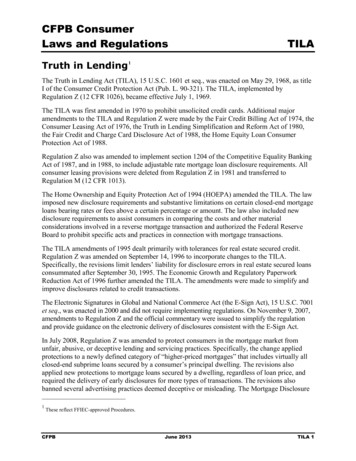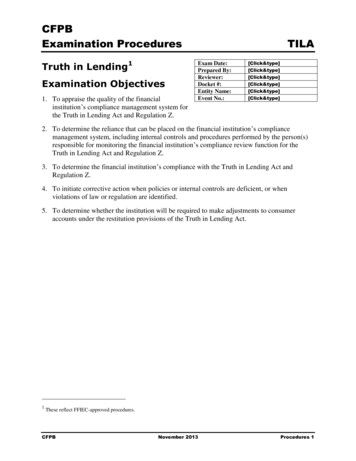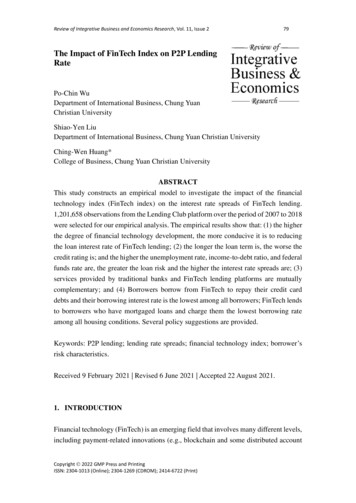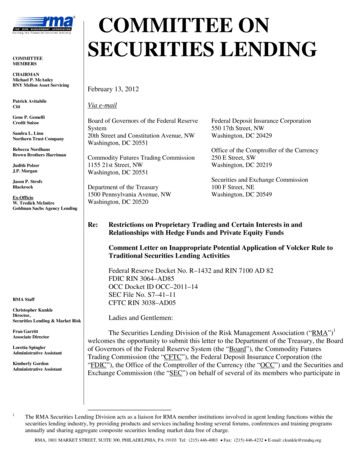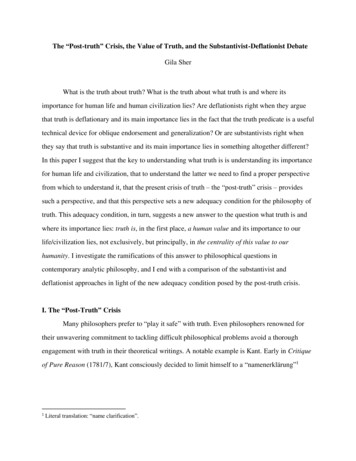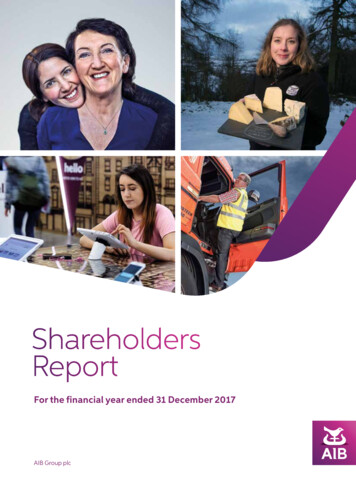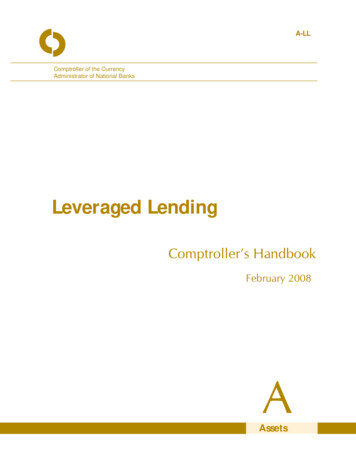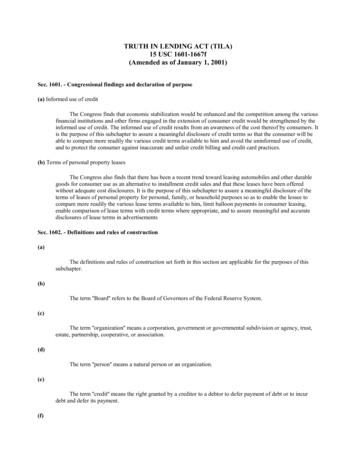
Transcription
TRUTH IN LENDING ACT (TILA)15 USC 1601-1667f(Amended as of January 1, 2001)Sec. 1601. - Congressional findings and declaration of purpose(a) Informed use of creditThe Congress finds that economic stabilization would be enhanced and the competition among the variousfinancial institutions and other firms engaged in the extension of consumer credit would be strengthened by theinformed use of credit. The informed use of credit results from an awareness of the cost thereof by consumers. Itis the purpose of this subchapter to assure a meaningful disclosure of credit terms so that the consumer will beable to compare more readily the various credit terms available to him and avoid the uninformed use of credit,and to protect the consumer against inaccurate and unfair credit billing and credit card practices.(b) Terms of personal property leasesThe Congress also finds that there has been a recent trend toward leasing automobiles and other durablegoods for consumer use as an alternative to installment credit sales and that these leases have been offeredwithout adequate cost disclosures. It is the purpose of this subchapter to assure a meaningful disclosure of theterms of leases of personal property for personal, family, or household purposes so as to enable the lessee tocompare more readily the various lease terms available to him, limit balloon payments in consumer leasing,enable comparison of lease terms with credit terms where appropriate, and to assure meaningful and accuratedisclosures of lease terms in advertisementsSec. 1602. - Definitions and rules of construction(a)The definitions and rules of construction set forth in this section are applicable for the purposes of thissubchapter.(b)The term ''Board'' refers to the Board of Governors of the Federal Reserve System.(c)The term ''organization'' means a corporation, government or governmental subdivision or agency, trust,estate, partnership, cooperative, or association.(d)The term ''person'' means a natural person or an organization.(e)The term ''credit'' means the right granted by a creditor to a debtor to defer payment of debt or to incurdebt and defer its payment.(f)
The term ''creditor'' refers only to a person who both(1)regularly extends, whether in connection with loans, sales of property or services, or otherwise,consumer credit which is payable by agreement in more than four installments or for which the paymentof a finance charge is or may be required, and(2)is the person to whom the debt arising from the consumer credit transaction is initially payable onthe face of the evidence of indebtedness or, if there is no such evidence of indebtedness, by agreement.Notwithstanding the preceding sentence, in the case of an open-end credit plan involving a credit card,the card issuer and any person who honors the credit card and offers a discount which is a finance chargeare creditors. For the purpose of the requirements imposed under part D of this subchapter and sections1637(a)(5), 1637(a)(6), 1637(a)(7), 1637(b)(1), 1637(b)(2), 1637(b)(3), 1637(b)(8), and 1637(b)(10) ofthis title, the term ''creditor'' shall also include card issuers whether or not the amount due is payable byagreement in more than four installments or the payment of a finance charge is or may be required, andthe Board shall, by regulation, apply these requirements to such card issuers, to the extent appropriate,even though the requirements are by their terms applicable only to creditors offering open-end creditplans. Any person who originates 2 or more mortgages referred to in subsection (aa) of this section inany 12-month period or any person who originates 1 or more such mortgages through a mortgage brokershall be considered to be a creditor for purposes of this subchapter.(g)The term ''credit sale'' refers to any sale in which the seller is a creditor. The term includes any contract inthe form of a bailment or lease if the bailee or lessee contracts to pay as compensation for use a sumsubstantially equivalent to or in excess of the aggregate value of the property and services involved and it isagreed that the bailee or lessee will become, or for no other or a nominal consideration has the option to become,the owner of the property upon full compliance with his obligations under the contract.(h)The adjective ''consumer'', used with reference to a credit transaction, characterizes the transaction as onein which the party to whom credit is offered or extended is a natural person, and the money, property, orservices which are the subject of the transaction are primarily for personal, family, or household purposes.(i)The term ''open end credit plan'' means a plan under which the creditor reasonably contemplates repeatedtransactions, which prescribes the terms of such transactions, and which provides for a finance charge whichmay be computed from time to time on the outstanding unpaid balance. A credit plan which is an open endcredit plan within the meaning of the preceding sentence is an open end credit plan even if credit information isverified from time to time.(j)The term ''adequate notice,'' as used in section 1643 of this title, means a printed notice to a cardholderwhich sets forth the pertinent facts clearly and conspicuously so that a person against whom it is to operatecould reasonably be expected to have noticed it and understood its meaning. Such notice may be given to acardholder by printing the notice on any credit card, or on each periodic statement of account, issued to thecardholder, or by any other means reasonably assuring the receipt thereof by the cardholder.
(k)The term ''credit card'' means any card, plate, coupon book or other credit device existing for the purposeof obtaining money, property, labor, or services on credit.(l)The term ''accepted credit card'' means any credit card which the cardholder has requested and received orhas signed or has used, or authorized another to use, for the purpose of obtaining money, property, labor, orservices on credit.(m)The term ''cardholder'' means any person to whom a credit card is issued or any person who has agreedwith the card issuer to pay obligations arising from the issuance of a credit card to another person.(n)The term ''card issuer'' means any person who issues a credit card, or the agent of such person with respectto such card.(o)The term ''unauthorized use,'' as used in section 1643 of this title, means a use of a credit card by a personother than the cardholder who does not have actual, implied, or apparent authority for such use and from whichthe cardholder receives no benefit.(p)The term ''discount'' as used in section 1666f of this title means a reduction made from the regular price.The term ''discount'' as used in section 1666f of this title shall not mean a surcharge.(q)The term ''surcharge'' as used in this section and section 1666f of this title means any means of increasingthe regular price to a cardholder which is not imposed upon customers paying by cash, check, or similar means.''(r)The term ''State'' refers to any State, the Commonwealth of Puerto Rico, the District of Columbia, and anyterritory or possession of the United States.(s)The term ''agricultural purposes'' includes the production, harvest, exhibition, marketing, transportation,processing, or manufacture of agricultural products by a natural person who cultivates, plants, propagates, ornurtures those agricultural products, including but not limited to the acquisition of farmland, real property with afarm residence, and personal property and services used primarily in farming.(t)
The term ''agricultural products'' includes agricultural, horticultural, viticultural, and dairy products,livestock, wildlife, poultry, bees, forest products, fish and shellfish, and any products thereof, includingprocessed and manufactured products, and any and all products raised or produced on farms and any processedor manufactured products thereof.(u)The term ''material disclosures'' means the disclosure, as required by this subchapter, of the annualpercentage rate, the method of determining the finance charge and the balance upon which a finance charge willbe imposed, the amount of the finance charge, the amount to be financed, the total of payments, the number andamount of payments, the due dates or periods of payments scheduled to repay the indebtedness, and thedisclosures required by section 1639(a) of this title.(v)The term ''dwelling'' means a residential structure or mobile home which contains one to four familyhousing units, or individual units of condominiums or cooperatives.(w)The term ''residential mortgage transaction'' means a transaction in which a mortgage, deed of trust,purchase money security interest arising under an installment sales contract, or equivalent consensual securityinterest is created or retained against the consumer's dwelling to finance the acquisition or initial construction ofsuch dwelling.(x)As used in this section and section 1666f of this title, the term ''regular price'' means the tag or posted pricecharged for the property or service if a single price is tagged or posted, or the price charged for the property orservice when payment is made by use of an open-end credit plan or a credit card if either(1)no price is tagged or posted, or(2)two prices are tagged or posted, one of which is charged when payment is made by use of an openend credit plan or a credit card and the other when payment is made by use of cash, check, or similarmeans. For purposes of this definition, payment by check, draft, or other negotiable instrument whichmay result in the debiting of an open-end credit plan or a credit cardholder's open-end account shall notbe considered payment made by use of the plan or the account.(y)Any reference to any requirement imposed under this subchapter or any provision thereof includesreference to the regulations of the Board under this subchapter or the provision thereof in question.(z)The disclosure of an amount or percentage which is greater than the amount or percentage required to bedisclosed under this subchapter does not in itself constitute a violation of this subchapter.
(aa)(1)A mortgage referred to in this subsection means a consumer credit transaction that is secured bythe consumer's principal dwelling, other than a residential mortgage transaction, a reverse mortgagetransaction, or a transaction under an open end credit plan, if (A)the annual percentage rate at consummation of the transaction will exceed by more than 10percentage points the yield on Treasury securities having comparable periods of maturity on thefifteenth day of the month immediately preceding the month in which the application for theextension of credit is received by the creditor; or(B)the total points and fees payable by the consumer at or before closing will exceed thegreater of (i)8 percent of the total loan amount; or(ii) 400.(2)(A)After the 2-year period beginning on the effective date of the regulations promulgatedunder section 155 of the Riegle Community Development and Regulatory Improvement Act of1994, and no more frequently than biennially after the first increase or decrease under thissubparagraph, the Board may by regulation increase or decrease the number of percentage pointsspecified in paragraph (1)(A), if the Board determines that the increase or decrease is (i)consistent with the consumer protections against abusive lending provided by theamendments made by subtitle B of title I of the Riegle Community Development andRegulatory Improvement Act of 1994; and(ii)warranted by the need for credit.(B)An increase or decrease under subparagraph (A) may not result in the number ofpercentage points referred to in subparagraph (A) being -
(i)less that 8 percentage points; or(ii)greater than 12 percentage points.(C)In determining whether to increase or decrease the number of percentage points referred toin subparagraph (A), the Board shall consult with representatives of consumers, including lowincome consumers, and lenders.(3)The amount specified in paragraph (1)(B)(ii) shall be adjusted annually on January 1 by the annualpercentage change in the Consumer Price Index, as reported on June 1 of the year preceding suchadjustment.(4)For purposes of paragraph (1)(B), points and fees shall include (A)all items included in the finance charge, except interest or the time-price differential;(B)all compensation paid to mortgage brokers;(C)each of the charges listed in section 1605(e) of this title (except an escrow for futurepayment of taxes), unless (i)the charge is reasonable;(ii)the creditor receives no direct or indirect compensation; and(iii)the charge is paid to a third party unaffiliated with the creditor; and(D)
such other charges as the Board determines to be appropriate.(5)This subsection shall not be construed to limit the rate of interest or the finance charge that aperson may charge a consumer for any extension of credit.(bb)The term ''reverse mortgage transaction'' means a nonrecourse transactionin which a mortgage, deed of trust, or equivalent consensual securityinterest is created against the consumer's principal dwelling (1)securing one or more advances; and(2)with respect to which the payment of any principal, interest, and shared appreciation or equity isdue and payable (other than in the case of default) only after (A)the transfer of the dwelling;(B)the consumer ceases to occupy the dwelling as a principal dwelling; or(C)the death of the consumerSec. 1603. - Exempted transactionsThis subchapter does not apply to the following:(1)Credit transactions involving extensions of credit primarily for business, commercial, oragricultural purposes, or to government or governmental agencies or instrumentalities, or toorganizations.(2)Transactions in securities or commodities accounts by a broker-dealer registered with theSecurities and Exchange Commission.(3)
Credit transactions, other than those in which a security interest is or will be acquired in realproperty, or in personal property used or expected to be used as the principal dwelling of the consumer,in which the total amount financed exceeds 25,000.(4)Transactions under public utility tariffs, if the Board determines that a State regulatory bodyregulates the charges for the public utility services involved, the charges for delayed payment, and anydiscount allowed for early payment.(5)Transactions for which the Board, by rule, determines that coverage under this subchapter is notnecessary to carry out the purposes of this subchapter.(6) Repealed. Pub.L. 96-221, title VI, Sec. 603(c)(3), Mar. 31, 1980, 94 Stat. 169.(7)Loans made, insured, or guaranteed pursuant to a program authorized by title IV of the HigherEducation Act of 1965 (20 U.S.C. 1070 et seq., 42 U.S.C. 2751 et seq.)Sec. 1604. - Disclosure guidelines(a) Promulgation, contents, etc., of regulationsThe Board shall prescribe regulations to carry out the purposes of this subchapter. Except in the case of amortgage referred to in section 1602(aa) of this title, these regulations may contain such classifications,differentiations, or other provisions, and may provide for such adjustments and exceptions for any class oftransactions, as in the judgment of the Board are necessary or proper to effectuate the purposes of thissubchapter, to prevent circumvention or evasion thereof, or to facilitate compliance therewith.(b) Model disclosure forms and clauses; publication, criteria, compliance, etc.The Board shall publish model disclosure forms and clauses for common transactions to facilitatecompliance with the disclosure requirements of this subchapter and to aid the borrower or lessee inunderstanding the transaction by utilizing readily understandable language to simplify the technicalnature of the disclosures. In devising such forms, the Board shall consider the use by creditors or lessorsof data processing or similar automated equipment. Nothing in this subchapter may be construed torequire a creditor or lessor to use any such model form or clause prescribed by the Board under thissection. A creditor or lessor shall be deemed to be in compliance with the disclosure provisions of thissubchapter with respect to other than numerical disclosures if the creditor or lessor(1)uses any appropriate model form or clause as published by the Board, or(2)uses any such model form or clause and changes it by
(A)deleting any information which is not required by this subchapter, or(B)rearranging the format, if in making such deletion or rearranging the format, the creditor orlessor does not affect the substance, clarity, or meaningful sequence of the disclosure.(c) Procedures applicable for adoption of model forms and clausesModel disclosure forms and clauses shall be adopted by the Board after notice duly given in the FederalRegister and an opportunity for public comment in accordance with section 553 of title 5.(d) Effective dates of regulations containing new disclosure requirementsAny regulation of the Board, or any amendment or interpretation thereof, requiring any disclosure whichdiffers from the disclosures previously required by this part, part D, or part E of this subchapter or by anyregulation of the Board promulgated thereunder shall have an effective date of that October 1 which follows byat least six months the date of promulgation, except that the Board may at its discretion take interim action byregulation, amendment, or interpretation to lengthen the period of time permitted for creditors or lessors toadjust their forms to accommodate new requirements or shorten the length of time for creditors or lessors tomake such adjustments when it makes a specific finding that such action is necessary to comply with thefindings of a court or to prevent unfair or deceptive disclosure practices. Notwithstanding the previous sentence,any creditor or lessor may comply with any such newly promulgated disclosure requirements prior to theeffective date of the requirements.(f)Exemption authority(1) In generalThe Board may exempt, by regulation, from all or part of this subchapter any class of transactions,other than transactions involving any mortgage described in section 1602(aa) of this title, for which, inthe determination of the Board, coverage under all or part of this subchapter does not provide ameaningful benefit to consumers in the form of useful information or protection.(2) Factors for considerationIn determining which classes of transactions to exempt in whole or in part under paragraph (1), theBoard shall consider the following factors and publish its rationale at the time a proposed exemption ispublished for comment:(A)The amount of the loan and whether the disclosures, right of rescission, and otherprovisions provide a benefit to the consumers who are parties to such transactions, as determinedby the Board.(B)
The extent to which the requirements of this subchapter complicate, hinder, or make moreexpensive the credit process for the class of transactions.(C)The status of the borrower, including (i)any related financial arrangements of the borrower, as determined by the Board;(ii)the financial sophistication of the borrower relative to the type of transaction; and(iii)the importance to the borrower of the credit, related supporting property, and coverageunder this subchapter, as determined by the Board;(D)whether the loan is secured by the principal residence of the consumer; and(E)whether the goal of consumer protection would be undermined by such an exemption.(g) Waiver for certain borrowers(1) In generalThe Board, by regulation, may exempt from the requirements of this subchapter certain credittransactions if (A)the transaction involves a consumer (i)with an annual earned income of more than 200,000; or(ii)having net assets in excess of 1,000,000 at the time of the transaction; and(B)a waiver that is handwritten, signed, and dated by the consumer is first obtained from theconsumer.
(2) Adjustments by the BoardThe Board, at its discretion, may adjust the annual earned income and net asset requirements ofparagraph (1) for inflationSec. 1605. - Determination of finance charge(a) ''Finance charge'' definedExcept as otherwise provided in this section, the amount of the finance charge in connection with anyconsumer credit transaction shall be determined as the sum of all charges, payable directly or indirectly by theperson to whom the credit is extended, and imposed directly or indirectly by the creditor as an incident to theextension of credit. The finance charge does not include charges of a type payable in a comparable cashtransaction. The finance charge shall not include fees and amounts imposed by third party closing agents(including settlement agents, attorneys, and escrow and title companies) if the creditor does not require theimposition of the charges or the services provided and does not retain the charges. Examples of charges whichare included in the finance charge include any of the following types of charges which are applicable:(1)Interest, time price differential, and any amount payable under a point, discount, or other system oradditional charges.(2)Service or carrying charge.(3)Loan fee, finder's fee, or similar charge.(4)Fee for an investigation or credit report.(5)Premium or other charge for any guarantee or insurance protecting the creditor against theobligor's default or other credit loss.(6)Borrower-paid mortgage broker fees, including fees paid directly to the broker or the lender (fordelivery to the broker) whether such fees are paid in cash or financed.(b) Life, accident, or health insurance premiums included in finance chargeCharges or premiums for credit life, accident, or health insurance written in connection with any consumercredit transaction shall be included in the finance charges unless(1)
the coverage of the debtor by the insurance is not a factor in the approval by the creditor of theextension of credit, and this fact is clearly disclosed in writing to the person applying for or obtaining theextension of credit; and(2)in order to obtain the insurance in connection with the extension of credit, the person to whom thecredit is extended must give specific affirmative written indication of his desire to do so after writtendisclosure to him of the cost thereof.(c) Property damage and liability insurance premiums included in finance chargeCharges or premiums for insurance, written in connection with any consumer credit transaction, againstloss of or damage to property or against liability arising out of the ownership or use of property, shall beincluded in the finance charge unless a clear and specific statement in writing is furnished by the creditor to theperson to whom the credit is extended, setting forth the cost of the insurance if obtained from or through thecreditor, and stating that the person to whom the credit is extended may choose the person through which theinsurance is to be obtained.(d) Items exempted from computation of finance charge in all credit transactionsIf any of the following items is itemized and disclosed in accordance with the regulations of the Board inconnection with any transaction, then the creditor need not include that item in the computation of the financecharge with respect to that transaction:(1)Fees and charges prescribed by law which actually are or will be paid to public officials fordetermining the existence of or for perfecting or releasing or satisfying any security related to the credittransaction.(2)The premium payable for any insurance in lieu of perfecting any security interest otherwiserequired by the creditor in connection with the transaction, if the premium does not exceed the fees andcharges described in paragraph (1) which would otherwise be payable.(3)Any tax levied on security instruments or on documents evidencing indebtedness if the payment ofsuch taxes is a precondition for recording the instrument securing the evidence of indebtedness.(e) Items exempted from computation of finance charge in extensions of credit secured by an interest in real propertyThe following items, when charged in connection with any extension of credit secured by an interest inreal property, shall not be included in the computation of the finance charge with respect to that transaction:(1)Fees or premiums for title examination, title insurance, or similar purposes.(2)
Fees for preparation of loan-related documents.(3)Escrows for future payments of taxes and insurance.(4)Fees for notarizing deeds and other documents.(5)Appraisal fees, including fees related to any pest infestation or flood hazard inspections conductedprior to closing.(6)Credit reports.(f) Tolerances for accuracyIn connection with credit transactions not under an open end credit plan that are secured by real propertyor a dwelling, the disclosure of the finance charge and other disclosures affected by any finance charge (1)shall be treated as being accurate for purposes of this subchapter if the amount disclosed as thefinance charge (A)does not vary from the actual finance charge by more than 100; or(B)is greater than the amount required to be disclosed under this subchapter; and(2)shall be treated as being accurate for purposes of section 1635 of this title if (A)except as provided in subparagraph (B), the amount disclosed as the finance charge doesnot vary from the actual finance charge by more than an amount equal to one-half of one percentof the total amount of credit extended; or(B)in the case of a transaction, other than a mortgage referred to in section 1602(aa) of thistitle, which -
(i)is a refinancing of the principal balance then due and any accrued and unpaid financecharges of a residential mortgage transaction as defined in section 1602(w) of this title, oris any subsequent refinancing of such a transaction; and(ii)does not provide any new consolidation or new advance;if the amount disclosed as the finance charge does not vary from the actual finance chargeby more than an amount equal to one percent of the total amount of credit extendedSec. 1606. - Determination of annual percentage rate(a) ''Annual percentage rate'' definedThe annual percentage rate applicable to any extension of consumer credit shall be determined, inaccordance with the regulations of the Board,(1)in the case of any extension of credit other than under an open end credit plan, as(A)that nominal annual percentage rate which will yield a sum equal to the amount of thefinance charge when it is applied to the unpaid balances of the amount financed, calculatedaccording to the actuarial method of allocating payments made on a debt between the amountfinanced and the amount of the finance charge, pursuant to which a payment is applied first to theaccumulated finance charge and the balance is applied to the unpaid amount financed; or(B)the rate determined by any method prescribed by the Board as a method which materiallysimplifies computation while retaining reasonable accuracy as compared with the ratedetermined under subparagraph (A).(2)in the case of any extension of credit under an open end credit plan, as the quotient (expressed as apercentage) of the total finance charge for the period to which it relates divided by the amount uponwhich the finance charge for that period is based, multiplied by the number of such periods in a year.(b) Computation of rate of finance charges for balances within a specified rangeWhere a creditor imposes the same finance charge for balances within a specified range, the annualpercentage rate shall be computed on the median balance within the range, except that if the Board determinesthat a rate so computed would not be meaningful, or would be materially misleading, the annual percentage rateshall be computed on such other basis as the Board may be regulation require.(c) Allowable tolerances for purposes of compliance with disclosure requirements
The disclosure of an annual percentage rate is accurate for the purpose of this subchapter if the ratedisclosed is within a tolerance not greater than one-eighth of 1 per centum more or less than the actual rate orrounded to the nearest one-fourth of 1 per centum. The Board may allow a greater tolerance to simplifycompliance where irregular payments are involved.(d) Use of rate tables or charts having allowable variance from determined ratesThe Board may authorize the use of rate tables or charts which may provide for the disclosure of annualpercentage rates which vary from the rate determined in accordance with subsection (a)(1)(A) of this section bynot more than such tolerances as the Board may allow. The Board may not allow a tolerance greater than 8 percentum of that rate except to simplify compliance where irregular payments are involved.(e) Authorization of tolerances in determining annual percentage ratesIn the case of creditors determining the annual percentage rate in a manner other than as described insubsection (d) of this section, the Board may authorize other reasonable tolerancesSec. 1607. - Administrative enforcement(a) Enforcing agenciesCompliance with the requirements imposed under this subchapter shall be enforced under(1)section 8 of the Federal Deposit Insurance Act (12 U.S.C. 1818), in the case of (A)national banks, and Federal branches and Federal agencies of foreign banks, by the Officeof the Comptroller of the Currency;(B)member banks of the Federal Reserve System (other than national banks), branches andagencies of foreign banks (other than Federal branches, Federal agencies, and insured Statebranches of foreign banks), commercial lending companies owned or controlled by foreignbanks, and organizations operating under section 25 or 25(a) of the Federal Reserve Act (12U.S.C. 601 et seq., 611 et seq.), by the Board; and(C)banks insured by the Federal Deposit Insurance Corporation (other than members of theFederal Reserve System) and insured State branches of foreign banks, by the Board
the face of the evidence of indebtedness or, if there is no such evidence of indebtedness, by agreement. Notwithstanding the preceding sentence, in the case of an open-end credit plan involving a credit card, the card issuer and any person who honors the credit card and offers a discount which is a finance charge are creditors.
